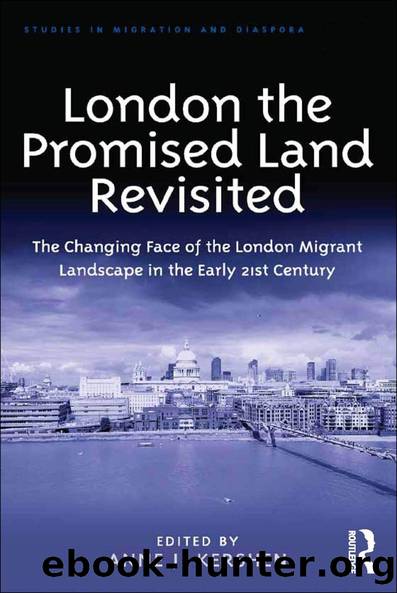London the Promised Land Revisited by Anne J. Kershen

Author:Anne J. Kershen [Kershen, Anne J.]
Language: eng
Format: epub
Tags: Social Science, Emigration & Immigration, Ethnic Studies, General
ISBN: 9781317103561
Google: 2dy1CwAAQBAJ
Publisher: Routledge
Published: 2016-03-09T05:07:28+00:00
Artistic Representations after the Second World War and the Growth of Identity Politics
Despite the continual flow of people from the empire before the Second World War, the students, sailors, servants and aristocrats did not intend to stay long. Those who settled were too few in number to create a significant local presence, even if some were able to facilitate the later growth of urban communities through their social networks. The arrival of workers from the empire from the late 1940s onwards led to a radical change in the ethnic and racial composition of many British cities, particularly London. The changes taking place within Britain were intimately linked to global developments as the empire began to unravel and artistic representations sought to express these transformations by drawing on the everyday lives of the emerging communities.
During the 1950s and 1960s those representations focused primarily on the political and cultural life of migrants from the Caribbean. The issue of âinner cityâ racial tensions had been highlighted by the so-called âNotting Hill riotsâ of 1958, increasing anti-immigrant political agitation and legislation designed to restrict immigration from the âNewâ Commonwealth. These political tensions formed the backdrop to a growing body of artistic representations, which sought to reflect the interests and aspirations of both the first and the emerging second generation of âblack Britishâ citizens. They drew on cultural traditions from the countries of origin as well as resources provided by the British cultural industry (music, poetry, novels, film, television and radio). In cinema Robeson and other African-American actors were followed by those from the Caribbean and Africa such as Robert Adams, who appeared in films from the 1920s and took the lead role in the 1946 film, Men of Two Worlds, where after a period as a musician in London he returns to his African village to teach music.3 Films begin to move from black characters as itinerants to placing them within black communities from the late 1950s. Sapphire (1959), Flame in the Streets (1961), A Taste of Honey (1962), The L-Shaped Room (1962) and To Sir With Love (1967) explored racial and sexual tensions in London locales. This development went in parallel with the contribution by gifted âblack and Asianâ writers such as Naipaul, Selvon, Chaudhuri, Collis, and Lamming. Yet these artists had little contact with the emerging migrant locales â their focus was on the white-dominated literary elite, the mainstream publishing industry and employment opportunities within the BBC (see Sandhu, 2003). It was in the area of music that a closer relationship was forged between artists and local black and Asian neighbourhoods, leading to the explorations by an increasing number of âblack and Asianâ academics from the 1980s such as Stuart Hall, Paul Gilroy, Sanjay Sharma and Claire Alexander.
These artistic and academic representations have also been accompanied by the growth of local âblack and Asianâ community and political activism. Community organisations, trade unions and political parties provided the platforms on which activists were able to build their following, emerging as borough councillors during the 1970s and 1980s mainly in âblack and Asianâ concentrations across London.
Download
This site does not store any files on its server. We only index and link to content provided by other sites. Please contact the content providers to delete copyright contents if any and email us, we'll remove relevant links or contents immediately.
Spell It Out by David Crystal(36013)
Life for Me Ain't Been No Crystal Stair by Susan Sheehan(35713)
Cecilia; Or, Memoirs of an Heiress — Volume 1 by Fanny Burney(32396)
Cecilia; Or, Memoirs of an Heiress — Volume 3 by Fanny Burney(31774)
Cecilia; Or, Memoirs of an Heiress — Volume 2 by Fanny Burney(31742)
The Great Music City by Andrea Baker(31223)
Professional Troublemaker by Luvvie Ajayi Jones(29561)
We're Going to Need More Wine by Gabrielle Union(18924)
The Secret History by Donna Tartt(18786)
Twilight of the Idols With the Antichrist and Ecce Homo by Friedrich Nietzsche(18469)
All the Missing Girls by Megan Miranda(15440)
Cat's cradle by Kurt Vonnegut(15125)
Pimp by Iceberg Slim(14251)
Bombshells: Glamour Girls of a Lifetime by Sullivan Steve(13940)
Talking to Strangers by Malcolm Gladwell(13156)
Norse Mythology by Gaiman Neil(13154)
Fifty Shades Freed by E L James(13138)
For the Love of Europe by Rick Steves(12433)
The Social Justice Warrior Handbook by Lisa De Pasquale(12098)
